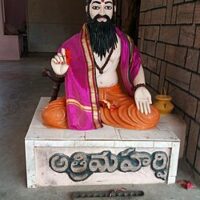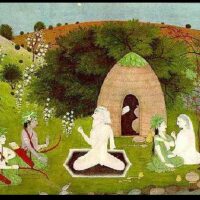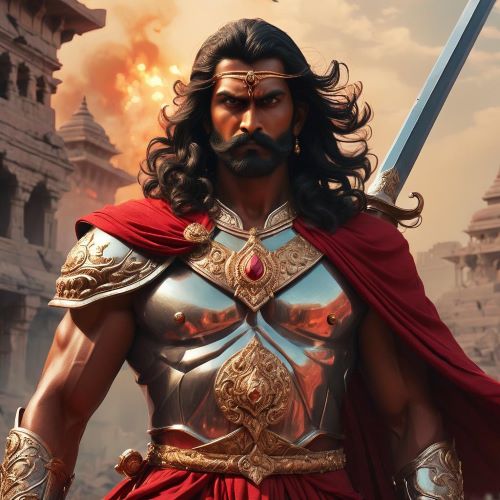Atri : The Immortal of Wisdom
Listen
At a glance
| Description | |
|---|---|
| Origin | Indian Mythology |
| Classification | Mortals |
| Family Members | Anasuya (Wife), Dattatreya, Durvasa, Chandra (Children) |
| Region | India |
| Associated With | Wisdom, Immortality |
Atri
Introduction
Atri, one of the most revered sages in Indiaan mythology, stands as a pillar of ancient wisdom and spiritual depth. Regarded as one of the Saptarishis—the seven eternal sages chosen by Lord Brahma—Atri’s influence stretches across the Vedas, Puranas, and epic narratives. He is known not only for his divine lineage and teachings but also for his role in shaping the spiritual and moral compass of ancient Indian society. Atri’s presence in Indian lore is both instructional and symbolic, offering insight into the ideal of a balanced life, unwavering devotion, and cosmic order.
Physical Traits
The ancient scriptures offer minimal focus on the physical appearance of Atri, consistent with how sages in Hinduism are often represented—as embodiments of spiritual energy rather than physical attributes. Where descriptions exist, they tend to reflect the archetype of a Vedic rishi: serene in demeanor, clad in simple garments, and radiating inner peace. Symbolically, Atri is believed to have emerged from Brahma’s tongue, a poetic metaphor for wisdom, truth, and mastery of sacred speech. Artistic representations depict him in deep meditation, adorned with a rudraksha mala and seated in hermitages amidst nature, exuding a sattvic (pure) aura.
Family
Atri’s family occupies a central place in Indian mythology, especially through the tales that surround his consort Anasuya. Anasuya is revered as an icon of chastity and spiritual fortitude. The couple’s union exemplifies an ideal household—where spiritual pursuits coexist with familial duties. Their lineage is as divine as it is legendary. They are the parents of three sons: Dattatreya, Durvasa, and Chandra, whose births are attributed to the blessings of the Trimurti—Brahma, Vishnu, and Shiva.
Dattatreya, the most prominent among them, is venerated as an incarnation embodying all three deities and is a patron of the Nath tradition. Durvasa, associated with Shiva, is known for his quick temper and powerful curses, which play critical roles in several epics. Chandra, identified with the moon, figures prominently in both astrological traditions and mythological narratives, and his progeny connects Atri’s lineage to the famed Kuru dynasty. Atri’s role in shaping these destinies cements his place as both a spiritual and paternal figure in the cosmos.
Other names
Atri is consistently known by his given name across Hindu scriptures, but his stature is acknowledged through various honorifics. He is called Maharshi, denoting a great sage, and is often grouped under the title of Saptarishi, a divine council of seven seers. In some texts, he is referred to as a Prajapati, indicating his role as one of the early progenitors created by Brahma. These epithets serve to emphasize his multifaceted contributions—as a progenitor, philosopher, Vedic scholar, and spiritual guide.
Powers and Abilities
Atri’s powers reflect his mastery over cosmic forces and spiritual knowledge. Among his most significant feats is his role in resolving a cosmic eclipse. As described in the Rigveda, when the demon Svarbhanu darkened the sun, Atri’s hymns dispelled the illusion, restoring light and order. This act not only symbolizes his spiritual might but also portrays him as a restorer of dharma in times of imbalance.
During a celestial conflict where the sun and moon were hidden by the asuras, Atri transformed himself into radiant orbs to aid the devas, demonstrating his ability to embody celestial elements. He also played a critical role in thwarting Indra’s interference in a sacred ritual, revealing divine truths and restoring cosmic balance. Another legend links him to the descent of the sacred river Ganga to Earth, underlining his contributions to the nourishment of both land and soul.
Moreover, Atri is recognized as a seer of mantras and the discoverer of the ‘U’ syllable in AUM, symbolizing preservation and linked to Lord Vishnu. His authorship of Mandala 5 in the Rigveda, comprising hymns dedicated to deities like Agni and Indra, showcases his literary and philosophical brilliance. His text, the Atri Samhita, lays down ethical and spiritual guidelines, focusing on self-restraint, charity, and compassion, which remain relevant to this day.
Modern Day Influence
Atri’s presence continues to permeate modern Hindu practice, philosophy, and cultural consciousness. His hymns are still chanted in Vedic rituals and ceremonies, especially those seeking wisdom, balance, and spiritual clarity. His ethical doctrines, preserved through scriptures like the Atri Samhita, offer guiding principles for contemporary living, promoting virtues such as non-violence, truth, and generosity.
His familial model—especially his life with Anasuya—is celebrated in Indian households as a template of spiritual harmony within domestic life. Temples and pilgrimage sites such as the Anasuya Ashram in Chitrakoot and Atri Kund near Bhubaneswar are frequented by devotees seeking blessings and spiritual insight.
His gotra (lineage) holds significance in Indian culture, especially among Brahmin and Vaishya communities, symbolizing the continuation of sacred tradition. In spiritual communities, Atri and the Saptarishis are invoked during meditation and introspection as embodiments of enlightenment and divine memory.
Atri’s teachings and symbolic legacy extend into modern discourses on environmentalism, ethics, and holistic wellness. His life encourages a balance between worldly responsibilities and spiritual pursuit, a principle that continues to find relevance in today’s world where individuals seek integration of material and spiritual life.
Related Images
Source
Wikipedia contributors. (2024). Atri. In Wikipedia. Retrieved from https://en.wikipedia.org/wiki/Atri
Hindu Mythology Worldwide. (2024). The Spiritual Journey of Sage Atri. Retrieved from https://hindu.mythologyworldwide.com/the-spiritual-journey-of-sage-atri
Divine Hindu. (2024). Sage Atri: Timeless Wisdom in Modern Indian Spirituality. Retrieved from https://divinehindu.com/sages/sage-atri-timeless-wisdom-in-modern-indian-spirituality
“About Atthiri Maharishi.” Jeevanadi.com, n.d. https://www.jeevanadi.com/About%20Atthiri%20Maharishi.html
“An examination of ‘Atri’s Eclipse’ as described in the Rig Veda.” arXiv.org, 2024. https://arxiv.org/pdf/2402.04690
“Rishi Atri’s Significance in Hindu Mythology: An Explanation – Poojn.in.” Poojn.in, n.d. https://www.poojn.in/blog/rishi-atri-in-hindu-mythology
“Sage Atri: Timeless Wisdom in Modern Hinduism – Divine Hindu.” Divine Hindu, 29 June 2024. https://www.divinehindu.com/rishi-atri/
“Saptrishi Atri – SanatanBrahmand.” SANATANBRAHMAND, n.d. https://sanatanbrahmand.com/saptrishi-atri/
“The Spiritual Journey of Sage Atri – Hindu Mythology.” Hindu Mythology Worldwide, n.d. https://hindumythologyworldwide.com/rishi-atri/
“Stories Of Sage Atri In Hinduism – Hindu Blog.” Hindu Blog, 1 Jan. 2025. https://www.hindublog.com/stories-of-sage-atri-in-hinduism/
“Story of Atri.” Wisdomlib.org, n.d. https://www.wisdomlib.org/hinduism/compendium/puranic-encyclopaedia/d/doc241838.html
Frequently Asked Questions
What is lorem Ipsum?
I am text block. Click edit button to change this text. Lorem ipsum dolor sit amet, consectetur adipiscing elit. Ut elit tellus, luctus nec ullamcorper mattis, pulvinar dapibus leo.
What is lorem Ipsum?
I am text block. Click edit button to change this text. Lorem ipsum dolor sit amet, consectetur adipiscing elit. Ut elit tellus, luctus nec ullamcorper mattis, pulvinar dapibus leo.
What is lorem Ipsum?
I am text block. Click edit button to change this text. Lorem ipsum dolor sit amet, consectetur adipiscing elit. Ut elit tellus, luctus nec ullamcorper mattis, pulvinar dapibus leo.
What is lorem Ipsum?
I am text block. Click edit button to change this text. Lorem ipsum dolor sit amet, consectetur adipiscing elit. Ut elit tellus, luctus nec ullamcorper mattis, pulvinar dapibus leo.
What is lorem Ipsum?
I am text block. Click edit button to change this text. Lorem ipsum dolor sit amet, consectetur adipiscing elit. Ut elit tellus, luctus nec ullamcorper mattis, pulvinar dapibus leo.












